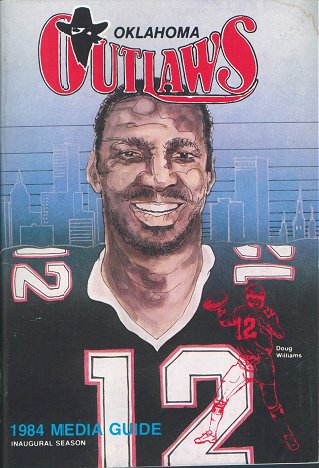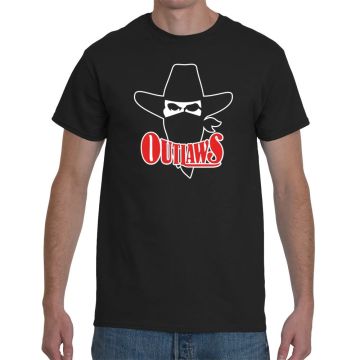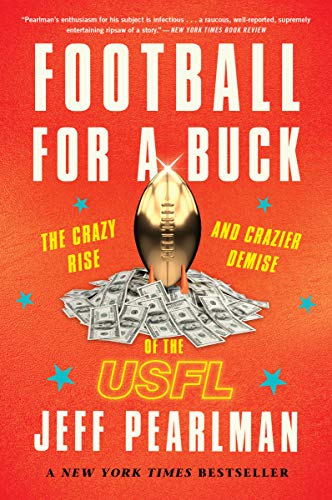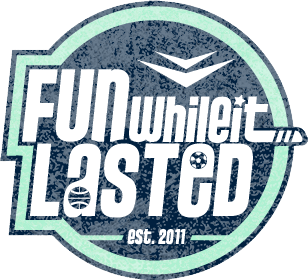United States Football League (1984)
Tombstone
Born: July 7, 1983 – USFL expansion franchise
Died: December 5, 1984 – Merged with Arizona Wranglers
First Game: February 26, 1984 (W 7-3 vs. Pittsburgh Maulers)
Last Game: June 24, 1984 (L 23-0 @ San Antonio Gunslingers)
USFL Championships: None
Stadium
Stadium: Skelly Stadium
Marketing
Team Colors:
Ownership
Owners: William Tatham, Sr. & Willliam Tatham, Jr.
Attendance
Tilting your mobile device may offer better viewing.
Sources:
- 1985 Sporting News USFL Guide & Register (Outlaws attendance; re-built from line scores)
- Oates, Bob. “USFL Shrinks, but Still Has a Large Problem: It’s Not Lack of Money or Quality of Its Players, It’s Convincing Television That There Are Fans”. The Times (Los Angeles, CA). February 4, 1985 (USFL league-wide attendance figure)
OUR FAVORITE STUFF
Oklahoma/Arizona Outlaws
USFL Logo T-Shirt
The Outlaws never quite put it all together on the field during their two USFL seasons, first in Tulsa, Oklahoma and later in Tempe, Arizona. But Outlaw veteran Doug Williams would go on the become the first former USFL QB to win a Super Bowl when he led the Redskins to victory in Super Bowl XXII in January 1988.
This 100% cotton Outlaws tee is available today in sizes Extra Small through 4XL from our friends at Royal Retros.
When you make a purchase through an affiliate link like this one, Fun While It Lasted earns a commission at no additional cost to you. Thanks for your support!
Background
The United States Football League awarded an expansion franchise to Fresno businessman William Tatham, Sr., his son William Tatham, Jr. and San Diego political consultant Ken Rietz on May 16th, 1983. Tatham Sr. was the former owner of the World Football League’s short-lived Portland Thunder franchise. The investors paid a $6 million expansion fee to join the springtime football league for its second season. Tatham and the USFL sought to place the club – due to begin play in March 1984 – at San Diego’s Jack Murphy Stadium. This marked the second time in two years that the USFL attempted to plant its flag in San Diego. The new league was first rebuffed by the city’s stadium committee in 1982. Investors Bill Daniels and Alan Harmon moved their franchise to the Los Angeles Coliseum instead.
Both USFL bids faced opposition from Jack Murphy’s three existing tenants, the Padres baseball team, the NFL’s San Diego Chargers and the San Diego Sockers of the North American Soccer League. While the Tatham group awaited a response from the City Council, the proposed club moved forward in other areas. The team hired Pro Football Hall-of-Fame and longtime San Diego Chargers head coach Sid Gillman as General Manager and began negotiating with Chargers All-Pro free agent quarterback Dan Fouts. But in mid-June 1983, the City Council voted 4-3 not to open lease negotiations with the USFL.
New City, New Quarterback
The Tathams now looked eastward to Tulsa, Oklahoma. On July 7th, 1983, the USFL formally announced the Oklahoma Outlaws as a new franchise for the 1984 season. The move was part of an aggressive expansion campaign by the young league. The USFL added six new cities for its second season after beginning play with twelve clubs in 1983. The Outlaws signed a lease with the University of Tulsa to play at 40,000-seat Skelly Stadium, which also played host to the Tulsa Roughnecks of the North American Soccer League.
On August 9, 1983 the Outlaws announced the signing of Tampa Bay Buccaneers free agent quarterback Doug Williams. The Bucs drafted Williams in 1978 out of Grambling, the first black quarterback ever selected in the first round of the NFL Draft. Between 1979 and 1982, Williams led the Bucs to three playoff appearances in four seasons and an appearance in the 1980 NFC Championship Game. Yet by the end of his fifth season, Williams remained one of the lowest paid starting quarterbacks in the NFL. His salary for the 1982 campaign was $120,000. Williams rejected a new contract from cheapskate Bucs owner Hugh Culverhouse to jump to the USFL.
Coaching Staff Struggles
 After the Williams signing, the Outlaws seemed to stall out for the remainder of 1983. The club made no other major free agent signings. 29-year old President William Tatham, Jr. fired Sid Gillman in December. He assumed the General Manager reigns himself. By January 1984, the Outlaws were the only team among the USFL’s 18 members without a coaching staff. The season opener was less than two months away. Three days before the USFL’s college draft in January 1984, Washington Redskins quarterbacks coach and former University of Tulsa star Jerry Rhome rejected the Outlaw’s contract offer.
After the Williams signing, the Outlaws seemed to stall out for the remainder of 1983. The club made no other major free agent signings. 29-year old President William Tatham, Jr. fired Sid Gillman in December. He assumed the General Manager reigns himself. By January 1984, the Outlaws were the only team among the USFL’s 18 members without a coaching staff. The season opener was less than two months away. Three days before the USFL’s college draft in January 1984, Washington Redskins quarterbacks coach and former University of Tulsa star Jerry Rhome rejected the Outlaw’s contract offer.
With Rhome out of the picture, the Tathams scrambled to hire Pittsburgh Steelers defensive assistant Woody Widenhofer. By Widenhofer’s own account, Tatham Jr. called him at 6:00 AM in the morning on January 2nd to offer him the job. Widenhofer didn’t know who Tatham was. He called a former Steelers colleague working in the USFL to confirm that Tatham actually owned the team. Nevertheless, Widenhofer accepted the job the next day. He had one day to prepare for the 1984 USFL draft, in which the Outlaws held the #2 overall selection. Only four of the Outlaws’ twenty-six open draft picks made the 1984 roster. The club failed to sign either of its first round selections, Ron Faurot or Conrad Goode.
Hot Start, Frigid Weather
The Oklahoma Outlaws made their USFL debut on February 26th, 1984 taking on the Pittsburgh Maulers at wet, frigid Skelly Stadium. The 20-degree windchill depressed attendance, with Outlaws officials providing unusually specific figures to the press: 11,638 in attendance with 4,300 no-shows. The Outlaws would go on to win six games in 1984 and they won all six in the rain.
 Less than a month into the Outlaws debut season in Tulsa, Owner/GM Bill Tatham Jr. announced that the club was unlikely to remain in Skelly Stadium. Tatham went on to claim that Honolulu, Indianapolis, Miami, Portland (Ore.) and Seattle had expressed interest in hosting the franchise. Tulsa was on notice that the Outlaws were lame ducks after only two home games.
Less than a month into the Outlaws debut season in Tulsa, Owner/GM Bill Tatham Jr. announced that the club was unlikely to remain in Skelly Stadium. Tatham went on to claim that Honolulu, Indianapolis, Miami, Portland (Ore.) and Seattle had expressed interest in hosting the franchise. Tulsa was on notice that the Outlaws were lame ducks after only two home games.
On the field, the Outlaws raced to a surprising 6-2 start. Ralph Wiley of Sports Illustrated profiled the team on April 23, 1984. Wiley noted that the Outlaws achieved their success despite a payroll of $2.1 million, second lowest in the 18-team USFL. The article also painted an unflattering portrait of the younger Tatham. Wiley noted that the novice football exec “seems to revel in issuing ultimatums.” After the Sports Illustrated feature appeared, the Outlaws lost ten straight games to finish the season at 6-12. Doug Williams had a poor season, hobbled by a knee injury and a thin supporting cast. Over 18 games, the Outlaws could not produce one running back who accumulated 300 yards rushing. Williams passed for 3,084 yards in 15 games, but completed less then 50% of his passes and threw 21 interceptions.
The End
Shortly after the Outlaws’ season ended in early July 1984, Tatham Jr. reiterated that the team would not return to Tulsa. Attendance did improve after the freezing opener. The Outlaws claimed 189,342 fans for the season for an average of 21,038 per game. Nevertheless, the Tathams projected a loss of $3 million. At the USFL owners meetings in August, a faction of USFL owners led by Donald Trump of the New Jersey Generals pushed through a resolution to move to a fall season in 1986. The USFL would play one final spring campaign in 1985.
This seismic move, combined with the substantial financial losses of many franchises, set off a flurry of merger and relocation talks. At the same August meeting, the league approved the merger of the Outlaws with the Oakland Invaders. The merged club would remain in Oakland under the Invaders name, with William Tatham Sr. and Invaders owner Tad Taube as equal partners. But by early October, the planned merger fell apart. The Invaders went on to combine with the Michigan Panthers. The Tathams shifted their sights to Arizona Wranglers owner Dr. Ted Diethrich.
Diethrich, a heart surgeon from Phoenix, was an original USFL investor. He had a good club: his Wranglers club appeared in the 1984 USFL Championship game. But by October 1984, he had lost lost approximately $14 million on the USFL in just over two years. Reported as a merger, the transaction saw the Tathams purchase controlling interest in the Wranglers in December 1984. The team took the name Arizona Outlaws and relocated to the Wranglers old home at Sun Devil Stadium in Tempe. Widenhofer and the Outlaws coaching staff were dismissed. .
The Arizona Outlaws played the final spring season of the USFL in 1985 and missed the playoffs. The franchise folded along with the rest of the league in August 1986.
Trivia
The Oklahoma Outlaws were one of three Tulsa sports teams to fold in 1984. The city’s long-time minor league hockey franchise, the Tulsa Oilers, folded in the spring, along with the rest of the Central Hockey League. The Tulsa Roughnecks soccer team closed down after seven seasons in September 1984.
Doug Williams returned to the NFL with the Washington Redskins in 1986. On January 31, 1988, Williams quarterbacked the Redskins to a 42-10 victory over the Denver Broncos in Super Bowl XXII. He was the first black quarterback to start in and win a Super Bowl. He also became the first of two USFL quarterbacks (Steve Young being the other) to win a Super Bowl. Coincidentally, Super Bowl XXII was played at San Diego’s Jack Murphy Stadium, where the Outlaws’ originally intended to play.
Voices
“Our open tryouts were interesting. One guy showed up in a tuxedo, ran the 40, and kept on going like Forrest Gump.”
– Gil Swalls, Director of Public Relations 1984 (2011 FWiL Interview)
“I have a USFL ball sign by both Sid Gillman and Doug Williams. I remember the day Sid got fired by Bill Tatham, Jr. Bill knew I had a good relationship with Sid, so he asked me to take a half dozen balls to his office and ask for his autograph while he was cleaning out his desk. That was bizarre, and Sid knew who it was for, but he smiled and signed them.
– Gil Swalls
“Bill Jr. came in to the office one day and announced to the staff that we were going to demand Tulsa build us a new domed stadium. My heart sank, because I knew we were heading from stability to crazy. I had no real inside knowledge about Bill’s financial status, his political skills, or his ability to pull off such a big project. But I did know Tulsa, and I was quite sure a domed stadium demand wasn’t going to fly. Maybe that was his way of moving the team. He kept talking about Oklahoma City, but I wasn’t sure if he had any real prospects there. Even though I felt this announcement was a mistake, I liked Bill and wanted him and all of us to succeed.”
– Gil Swalls
Oklahoma Outlaws Shop
USFL Mini-Helmets
Arizona Outlaws
Mini-Helmet
This USFL Mini Helmet is available through Royal Retros.
15 oz. mini helmet
Style worn by the Outlaws in 1985
Available in the classic helmet style by Schutt or modern style by Riddell
Typically ships in 3-5 business days
Fulfilled by 417 Helmets
When you make a purchase through an affiliate link like this one, Fun While It Lasted earns a commission at no additional cost to you. Thanks for your support!
Editor's Pick
Football For A Buck
The Crazy Rise and Crazier Demise of the USFL
By Jeff Pearlman
The United States Football League—known fondly to millions of sports fans as the USFL—did not merely challenge the NFL, but cause its owners and executives to collectively shudder. In its three seasons from 1983-85, it secured multiple television deals, drew millions of fans and launched the careers of legends such as Steve Young, Jim Kelly, Herschel Walker, and Reggie White. But then it died beneath the weight of a particularly egotistical and bombastic team owner—a New York businessman named Donald J. Trump.
In Football for a Buck, Jeff Pearlman draws on more than four hundred interviews to unearth all the salty, untold stories of one of the craziest sports entities to have ever captivated America. From 1980s drug excess to airplane brawls and player-coach punch outs, to backroom business deals and some of the most enthralling and revolutionary football ever seen, Pearlman transports readers back in time to this crazy, boozy, audacious, unforgettable era of the game. He shows how fortunes were made and lost on the backs of professional athletes and how, forty years ago, Trump was already a scoundrel and a spoiler.
When you make a purchase through an affiliate link like this one, Fun While It Lasted earns a commission at no additional cost to you. Thanks for your support!
Olkahoma Outlaws Video
The Outlaws take on Jim Kelly and the Houston Gamblers at the Astrodome. May 20th, 1984 ABC Sports broadcast.
Downloads
1984 Oklahoma Outlaws Results & Attendance
1984 Oklahoma Outlaws Schedule & Results
2011 FWiL Interview with Oklahoma Outlaws PR Director Gil Swalls
Links
“Just Winnin’ In The Rain“, Ralph Wiley, Sports Illustrated, April 23, 1984
###





